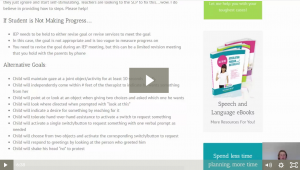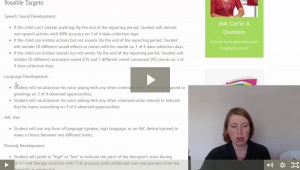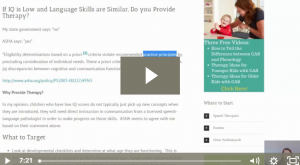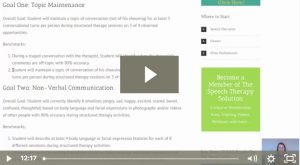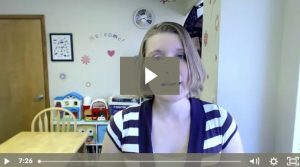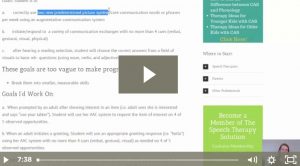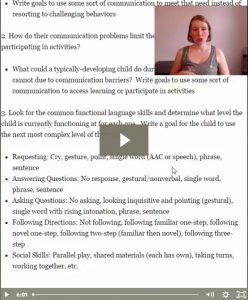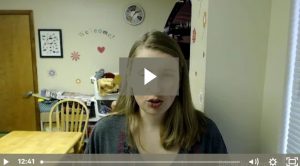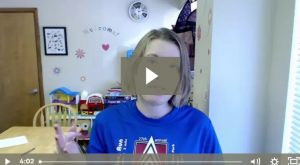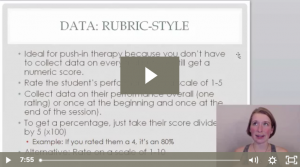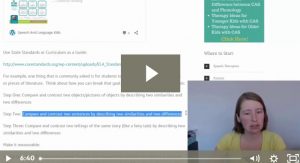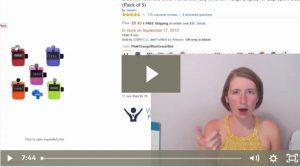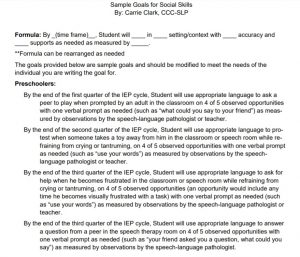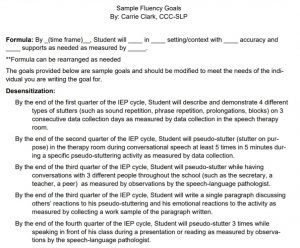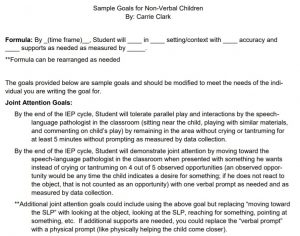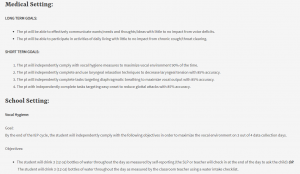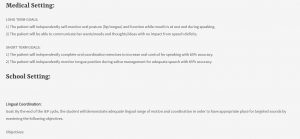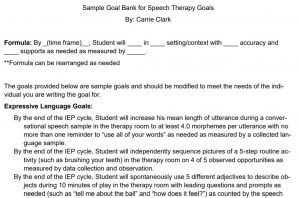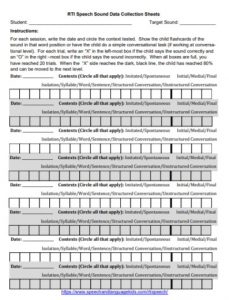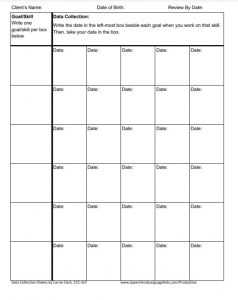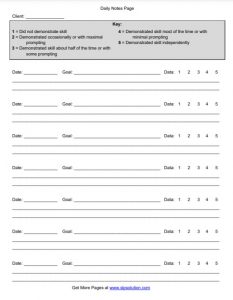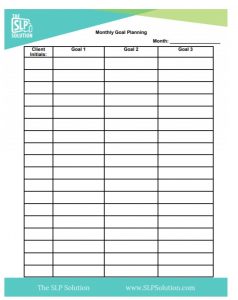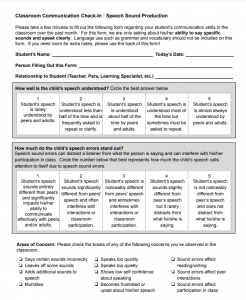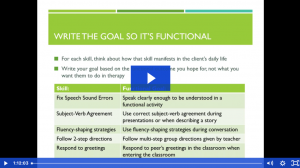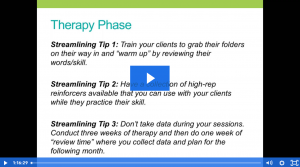Topic: Writing Goals and Collecting Data
Description:
The Process for Goal Writing:
Watch the video below for the steps to writing a good IEP goal. Or, scroll down to read the same information in text form:
The first step for writing any good goal is to identify the area of concern. These concerns should be written in the “Present Level of Academic Performance” area of the IEP (some schools/states name that area something slightly different). You can figure out what areas are of concern by using standardized tests, developmental checklists, common core curriculum benchmarks/standards, or any other skills assessments that you have access to. This section should also include information on how that area of concern impacts the child in the educational setting.
For example, you could say “Jimmy is not able to stand on his head for more than 3 minutes.” That is definitely an area of concern for poor Jimmy. However, it is not educationally relevant. That is to say, his lack of head-stand skills is very unlikely to cause him problems in the classroom. Unless, of course, there is a head-stand competition and his grade depends on it…but let’s assume that’s probably not going to happen. For that reason, Jimmy’s head-stand disability should not be included in the present level of academic performance.
Instead, we should be writing things like “In spontaneous speech, Jimmy does not include any grammatical markers in his utterances. This makes his speech sound ‘telegraphic’ which causes him to be very difficult to understand. This impacts Jimmy’s ability to communicate his wants and needs with teachers and peers, participate in classroom discussions, and initiate and maintain appropriate relationships with peers.”
The key to this section is to write what the child is having difficulty with (specifically) and then how it impacts him in the classroom.
Here are a few examples of how communication delays may impact a child in the classroom:
- Difficulty being understood by teachers and peers
- Difficulty communicating basic wants and needs to teachers and peers
- Difficulty initiating and maintaining relationships with peers
- Difficulty participating in classroom discussions
- Making it difficult for teachers to assess knowledge and skill acquisition
- Difficulty understanding classroom texts and reading
- Difficulty following directions to complete educational tasks
- Difficulty following routines
- Difficulty understanding and retaining new concepts presented in class
- Difficulty attending to auditory/verbal stimuli
- Difficulty retelling past events in a logical manner or forming narratives
Ok, here’s a big takeaway guys. If you write a concern in the Present Level of Academic Performance, you need to address it somewhere in the IEP. That means, you can write a goal for how you will help the child overcome that concern. You could also write an accommodation or modification that will address the area of concern (such as sitting a child closer to the teacher to accommodate for attention or hearing problems). Just keep in mind that each area needs to be addressed. You can’t just say that something is a problem and then never say what you’re going to do about it.
Ok, so now that you know all of the areas you are going to write goals for, you need to sit down and write the goal. Don’t stress, I’ll help you! Here is a general framework that will help you think about your goals. Maybe you’ve heard of it, it’s called “S.M.A.R.T. Goal-Writing”. Every goal you write should be:
Specific
Measurable
Attainable
Relevant
Time-Bound
Let’s break it down:
Specific: Each goal should specifically state what the child will do. It should be so specific that a substitute could walk in, read the goal, watch the child, and then know exactly if the child can do that skill or not. Your goal should include what the child will do, in what setting he will do it, what accuracy he should do it with, and what kinds of support he should need.
Measurable: Each goal should specifically state how the skill will be measured. Make sure that you state not only how data will be collected but exactly what percentage/accuracy will be attained. You should also write this section so a substitute could come in and assess it without you explaining how.
Attainable: Make sure that the goal you set is something that you reasonably expect that the child will accomplish in the given time frame. I know this can be hard to do if you’re doing an evaluation and don’t know how quickly the child will progress, but take a good guess. The IEP can (and should) be revised halfway through the IEP cycle if the child is making faster or slower progress than expected.
Relevant: The goal should be relevant to each child’s individual needs. This means, you can’t just use the same goal for everyone on your caseload. Each goal should be customized to what that child needs. Also, the goals should be relevant to the child’s educational needs. We can go back to our example of head-stands as a goal that would not be relevant to a child’s educational needs.
Time-Bound: Each goal should explicitly say what time frame it will be achieved in. You can say things like “by the end of the IEP cycle…” or “in one year…” or “by ___ date…”. This allows you to specify if this is a goal that will take the child all year to accomplish or if you expect it to be mastered and knocked out of the way early on to leave time for working on harder skills.
The Formula for Writing Goals:
We’ve talked about all of the things that should be included in an IEP goal, but that’s a little wordy, so let’s simplify it. Here are the parts of the formula that need to be included in a good IEP goal:
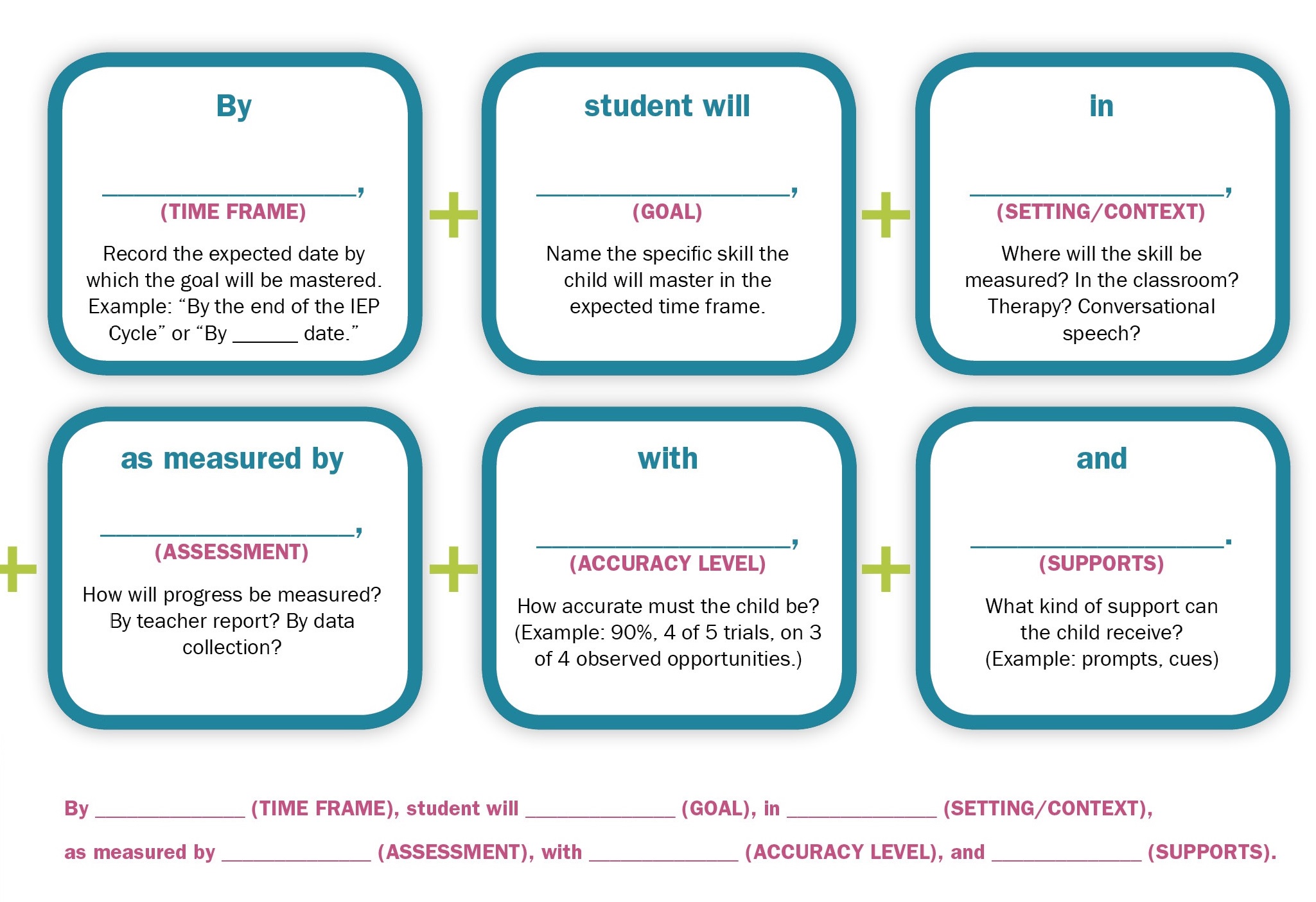
- By _____ (When the child will master the goal by: by the end of the IEP cycle, by a certain date, in six months)
- Student will _______ (Write the specific skill that the child will do)
- In ______ setting/context (Where will the skill be measured? In the classroom? In the therapy room? In conversational speech? At the sentence level? During peer interactions?)
- As measured by ______ (How will progress be measured? With data collection? By teacher report? A language sample? A checklist? A tally sheet?)
- With ____ accuracy (How accurate must the child be? Examples: 80% accuracy, in 4 of 5 trials, on 3 of 4 observed opportunities, on 5 consecutive data collection days)
- With ____ supports (Can the child have any supports and still be considered to have met the goal? Examples: Independently, with reminders, with verbal prompts, with physical prompts, with partial physical assistance, with visual cues)
Here is an example of how this may look:
By the end of the IEP cycle, Johnny will correctly produce the pronouns “he” and “she” when retelling a story that has just been read aloud in the speech therapy room as measured by data collection with at least 80% accuracy and no more than 2 reminders as needed.
Ok, I know that is quite a mouthful. But when you break it down, it has all of the information we need. These are not designed to be great conversational pieces. They are designed to convey enough information that if you passed your IEP on to another professional, they could pick up with exactly what you were intending to do. And remember, many children change schools or move mid-IEP cycle so that very well could happen to you! If you get a new kiddo, you’re going to want his goals to be written like this as well.
Including Baselines:
Some schools and states require that baselines be included in each IEP goal so it is clear where the child started and how far they’ve come. If you want or need to include baseline, you can add it to the above formula by replacing your “Student will”, “supports”, and “accuracy” sections with this:
“…student will increase/decrease ______ from a baseline of ____ accuracy with ____ supports to ____accuracy with _____ supports…”
An example goal would look like this:
By the end of the IEP cycle, Johnny will increase correct production of the pronouns “he” and “she” when retelling a story that has just been read aloud in the speech therapy room from a baseline of 57% accuracy with 3 reminders to at least 80% accuracy with no more than 2 reminders as needed.
You also may want to change the location of the goal from your baseline as well. For example, you could say that the child will go from doing a skill in the speech therapy room with 80% accuracy to in the classroom with 80% accuracy.
So what are benchmark goals for? Benchmark goals are “mini” goals that are the steps leading up to a bigger goal. Think of these as the skills that the child will need to learn before he can do the larger goal. For example, if a child is going to answer a variety of “where” questions about a story read aloud, then some benchmark goals may be to answer “where” questions by pointing (where’s the ball) and then answer “where” questions verbally about the location of objects immediately present (such as “where is the block? Under the table).
The key here is to include time stamps on when you expect these benchmark goals to be met by. If you do this right, you’ll be able to easily see if the child is making adequate progress to meet the overall goal.
Let’s take my example above and assume that your school district tracks and updates progress once per trimester. If that were the case, you could write the following goal and benchmark goals to get you there:
Overall Goal: By the end of the IEP cycle, Juliet will independently answer “where” questions about a book that has been read aloud in the therapy room with 80% accuracy as measured by data collection.
Benchmark 1: By the end of the first trimester of this IEP cycle, Juliet will independently answer a “where’s the ___” question by pointing to the correct object in the therapy room with 80% accuracy as measured by data collection.
Benchmark 2: By the end of the second trimester of this IEP cycle, Juliet will independently answer a “where’s the ____” question by verbally describing the location of the object in the therapy room with 80% accuracy as measured by data collection.
As you can see, the benchmarks follow the logical progression of skills that the child will need to learn how to answer “where” questions and can easily by measured by you or anyone else looking at the IEP. You’ll easily be able to tell at progress-reporting time if she’s on track to meet the goal. If she’s not, you can modify the IEP accordingly (during a formal IEP meeting!).
Goal-Writing Short Training Videos:
These short videos and guides will help you with various aspects of writing great goals:
Data Collection Short Training Videos:
These short videos and guides will help you with various aspects of collecting data:
Printable Resources:
These PDFs, printables, and cheat sheets will help you with your goal-writing and data collection:
Webinar Recordings:
Ready to dive deep? These hour-long webinar recordings will give you more information about this topic.

